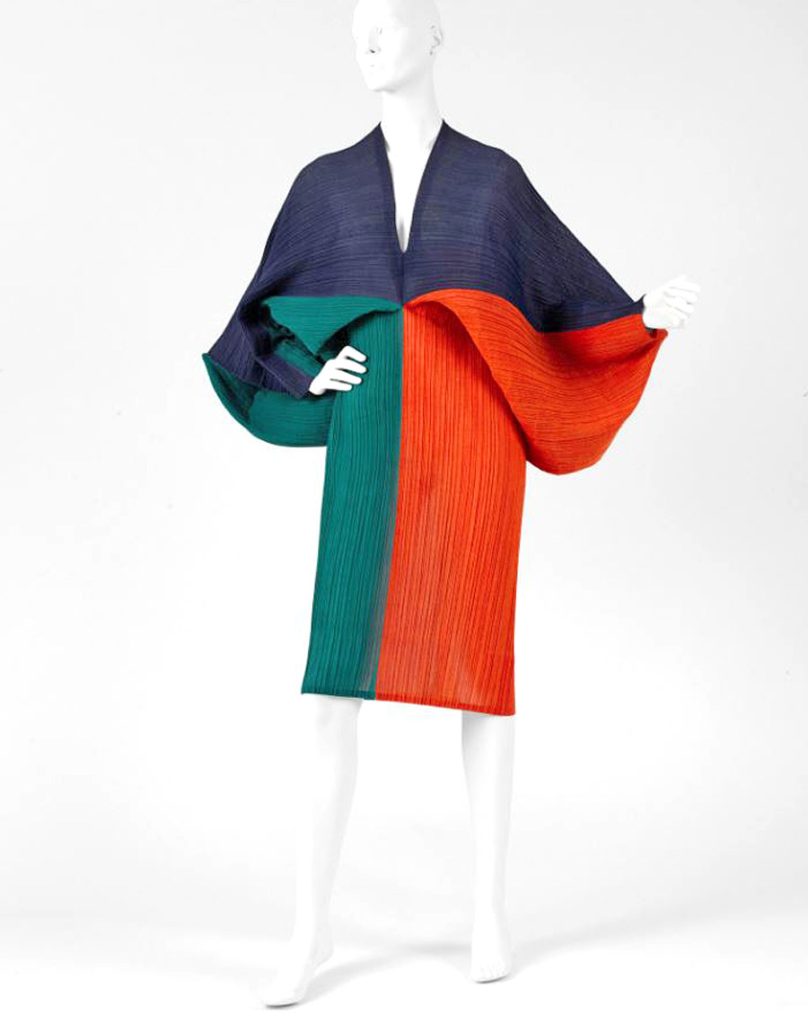
Photo: grailed.com
We’ve lost several highly consequential design legends these last few years. The latest is multi-talented Japanese designer Issey Miyake, who succumbed to liver cancer at age 84 on August 5th. Miyake, who launched his namesake women’s wear label in 1971, was a visionary and fashion industry pioneer dedicated to design innovation.

Photo: Pinterest.com
Best known for his origami-like garments, technological development of textiles, and unique approach to fashion, Issey tested the kinetic energy of fabrics by pleating and cutting cloth like a sculptor. Miyake’s technology-driven ethos and textile engineering were exemplified by his groundbreaking pleating technique, debuting in the brand’s Pleats Please line in 1993.

Photo: pinterest.com
Pleats took on new life in Miyake’s hands. In essence, he created an entirely new material whose iterations are infinite — a feat of technology as much as fashion. By using a heat press to cure his fabrics after his garments are stitched, Miyake maintained the accordion structure of the pleat, turning a series of folds into sculptural, often futuristic forms unbound by the shape of the human body. The pleats are permanent, and the garments can be worn and washed without losing shape.
Issey Miyake not only transformed the way clothes are made, but he was also one of the first fashion designers whose clothes were regarded as art.
Dr. Valerie Steele

Photo: Grailed.com
I reached out to Dr. Valerie Steele, Director, and Chief Curator, of The Museum at the Fashion Institute of Technology. I asked her to put Issey’s enormous influence on fashion in perspective. As she points out, their MFIT exhibition, Japan Fashion Now (2010), drew attention to Issey’s importance as one of the world’s most creative and influential designers, “but it was Miyake’s emphasis on the beauty of functionality that made his work resonate for so many people, for whom his pleated clothes epitomized physical and emotional liberation.”
Dr. Steele observes, “When Miyake’s clothes were featured on the cover of Artforum in 1982, it was a turning point in perceptions about the relationship between fashion and art. In the 1990s, he collaborated with several artists, such as Yasumasa Morimura, setting the stage for later design directors at Miyake, such as Naoki Takizawa, to work with contemporary artists such as Aya Takano.”
There have been countless tributes to Issey, who not only designed ready-to-wear but a line of bags in the name BAO BAO ISSEY MIYAKE, along with a memorable fragrance, L’Eau D’Issey known for its sharp aquatic undertones. Reading them refreshed my memory about Issey’s astounding past. I had almost forgotten that Issey worked for Geoffrey Beene, one of my true design heroes, in the 60s.

Photo: pinterest.com.
It makes perfect sense. Both men were obsessed with dancers, movement, and making modern clothes! Some fans took to social media to post favored images of Issey and his designs, and many posted pictures of their beloved Issey Miyake treasures. The greatest testimony for a designer is a satisfied customer.

Photograph by Bill Cunningham
I continue to love fashion after being in the business for 50+ years because of creators like Miyake. I am fortunate to own 4 of his iconic designs and can attest to the fact that they are magical. I purchased this insanely fabulous multi-striped poncho from a vintage dealer many years ago. Not only is it a work of art, but it folds and stores away like a dream.
It never loses its shape, and the pleats are permanent, as promised. It can be worn in several different ways, depending on my mood. And it’s comfortable! What more can you ask from a piece of clothing? It is a show-stopper, and I have worn it several times. I wore it to the NYBG Conservatory Ball in 2016. Bill Cunningham was there, and he photographed me wearing it. The picture, taken from the back, appeared in Bill’s Evening Hours coverage that weekend. Bill passed away a few weeks later.

I found this unique Matisse-inspired Issey Miyake poncho many years ago at the Manhattan Vintage Show. As an art aficionado with a particular love of Matisse, I was instantly drawn to this incredible piece with a different pattern on each side. In February 2018, when my vintage collection was the featured exhibit at this show, I displayed both ponchos, and they were among the items that attracted the most interest.

I purchased this huge (27.5 inches in width) red felt accordion pleated bag at the Manhattan Vintage Show a while back, and it was also on display at my exhibition. This truly rare and iconic piece was featured in “Handbags: The Power of the Purse” by Anna Johnson, which dates to 2001.

Photo: amarcordvintage.com.
Made in Japan of a 100% polyester red felted material with black edging, it has dual handle closure with a strap that wraps around to create a bow effect. The bag can be worn opened (surprisingly roomy) or closed, and like all Miyake’s designs, it is a weightless and practical work of art.

My white and black BAO BAO bag is graphic, soft, and light. Like all the other BAO BAO bags, it is designed with flexible functionality and transforms itself after handling to create dramatic new shapes or pack flat in a suitcase.

While this exact style is not obtainable now, many iterations are readily available in different colors, sizes, and shapes. I especially like the large Lucent tote, priced at $435 and for sale at bloomingdales.com.
“Freedom” was a key word in understanding Miyake’s fashion designs. What Miyake did had nothing to do with seasons or trends. He often said he did not consider himself “a fashion designer.” “Anything that’s in fashion goes out of style too quickly,” he told the magazine Parisvoice in 1998. “I don’t make fashion. I make clothes.” This says it all. Touche!
